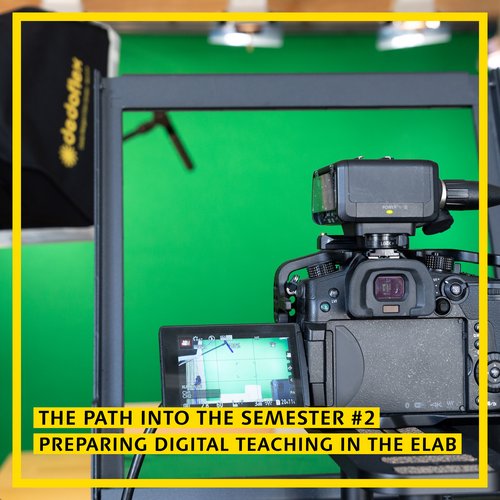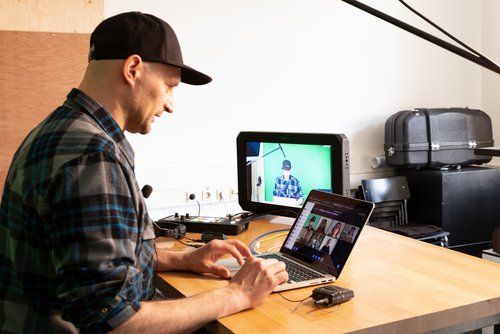The path into the semester #2 – »Preparing digital teaching in the eLab«
»Digital teaching« has long been practised at the Bauhaus-Universität Weimar. However, until now, digital tools have mainly been integrated into classroom teaching and used as a supplement. Digital teaching is currently being implemented throughout the country in the shortest possible time since it is currently not to rely on our traditional teaching and learning methods. Within a few weeks, the usual and planned teaching content must be digitally prepared, adapted, and new solutions must be found.
Technically, the university is well-positioned with the Moodle teaching platform, its own cloud storage and a broad range of software. Lecturers are supported by the eLab team, which is working hard to prepare the university for an optimal launch into the »Digital 2020 Summer Semester«. »Since it became clear a few weeks ago that the semester would not start as usual, we have become a sought-after contact point with the eLab. Until now, purely or predominantly digital teaching was not an option for most people,« says Jennifer Koch, an eLab employee. »Personal interaction or creative work in the studios and workshops is too important and actually prevents the shift to the virtual.«
However, because of the coronavirus outbreak, the existing paradigm has begun to shift. In the meantime, e-learning experts are constantly answering questions from lecturers every day. They discuss and design specific e-learning scenarios in writing, by telephone or in a specially-created virtual consultation session in order to meet the respective requirements in the various specialist areas. It is particularly important for the team to convey the fact that it is impossible to replace a face-to-face meeting with online teaching. Rather, digital teaching must be taken into consideration together with an adequate didactic concept for each respective course.
»Digital Toolbox« and individual advice
»A certain amount of previous experience with the various digital tools is of course an advantage, but the level of knowledge and experience varies significantly«, explains eLab employee Stepan Boldt. »While some have already tried out some things and would like to build on them, others now have to deal with the opportunities and limits of virtual teaching and learning for the first time.«
In order to cushion this – apart from the individual advice – the eLab has also massively expanded its online offer in the last three weeks. The »Digital Toolbox« provides an initial overview of the most important applications and how seminars and lectures can be designed. The Toolbox also contains various self-study courses and video tutorials to help you get started. In addition, the team has set up several self-study rooms in Moodle, where an »Introduction to media-supported teaching«, and topics such as »copyright challenges« and »evaluation formats in teaching« are offered. The entire range of courses, training and webinars is constantly being expanded.
A phone consultation can often compensate for scepticism or apparent excessive demands. »People are often subsequently relieved that things aren’t actually that complicated«, comments Steven Mehlhorn, an eLab employee. Additional support is also provided by the »eTutors«, student assistants who provide lecturers with targeted support on using digital tools in teaching and various online teaching and learning methods. Recently, the Presidium provided additional funds for the digital start in the 2020 summer semester that will help to cover their personnel costs, including a special call for ›eTutors‹. Applications can be submitted at any time. The student tutors are trained and accompanied by the eLab team. The online training covers both technical and didactic basics and is constantly being adapted to the current situation.
Moodle as a virtual classroom
Instead of going to lecture halls, seminar rooms or workshops, the daily study routine will begin with logging in to the Moodle platform. Until now, the teaching management platform – as the results of the 2019 survey of students on study conditions and concepts show – has mainly been used as a storage location for the digital semester collections. Now the platform must prove that it has the potential to become a central teaching and learning site.
The newly-implemented tool ›BigBlueButton‹ that enables students to interact and create discussion and feedback sessions online, is expected to play a decisive role here – a requirement for digital teaching that is very important to lecturers, as reported by the eLab team. There is also a need for ways to ensure that students' learning progress is maintained. This is where the ›h5p‹ software (also integrated into Moodle) can be used to create interactive presentations. This software allows integration of various kinds of quizzes, among other things.
»In some courses, it's very important to be able to provide large amounts of graphic material. Nextcloud can be used to do this«, recommends Christine Hess, eLab employee. »The material can be stored in the cloud storage of the Bauhaus-Universität Weimar, where it can be shared and used with the students for a certain period of time under password protection.«
What about Skype, Zoom, GoogleDocs, etc.?
Why use Moodle, Nextcloud and make the effort to learn how to use new tools, when almost all students are familiar with services like Skype, Zoom, Dropbox or Google Docs? After all, the range of freely accessible communication services, cloud solutions and project management tools is larger than ever. At closer glance, however, these don't comply with the data protection guidelines of the Free State of Thuringia or those of the Bauhaus-Universität Weimar and an express warning is issued against their use. Apart from the often mandatory additional registration via a separate account with the respective service, storing and forwarding data is often problematic. When it comes to using external tools, the eLab team would like to point out that this must be checked with the university’s data protection, Jens-Uwe Wagner.
The challenges of a digital classroom
From the beginning of May, both lecturers and students will have to find their way around their new, virtual learning location. Steven Mehlhorn has been involved in digital learning and teaching for several years and understands that the short-term changeover poses a major challenge for many: »Digital teaching is much clearer in terms of content. The most important thing is that we are well prepared.« Digital interactions are also more controlled than usual: who is going to talk, and for how long? When is the proper time for an objection? If any sessions reveal that participants have not understood something correctly or are just bored, new ways must now be found to create a positive learning experience for all.
This will depend to a large extent on the technology, especially cameras and microphones, and the quality of the Internet connections.
4. May will be the test for how successfully the digital semester starts off. Until then, we will continue preparing in the individual faculties and planning new teaching formats and content for the summer semester 2020, which will be covered in the next articles in this series.


